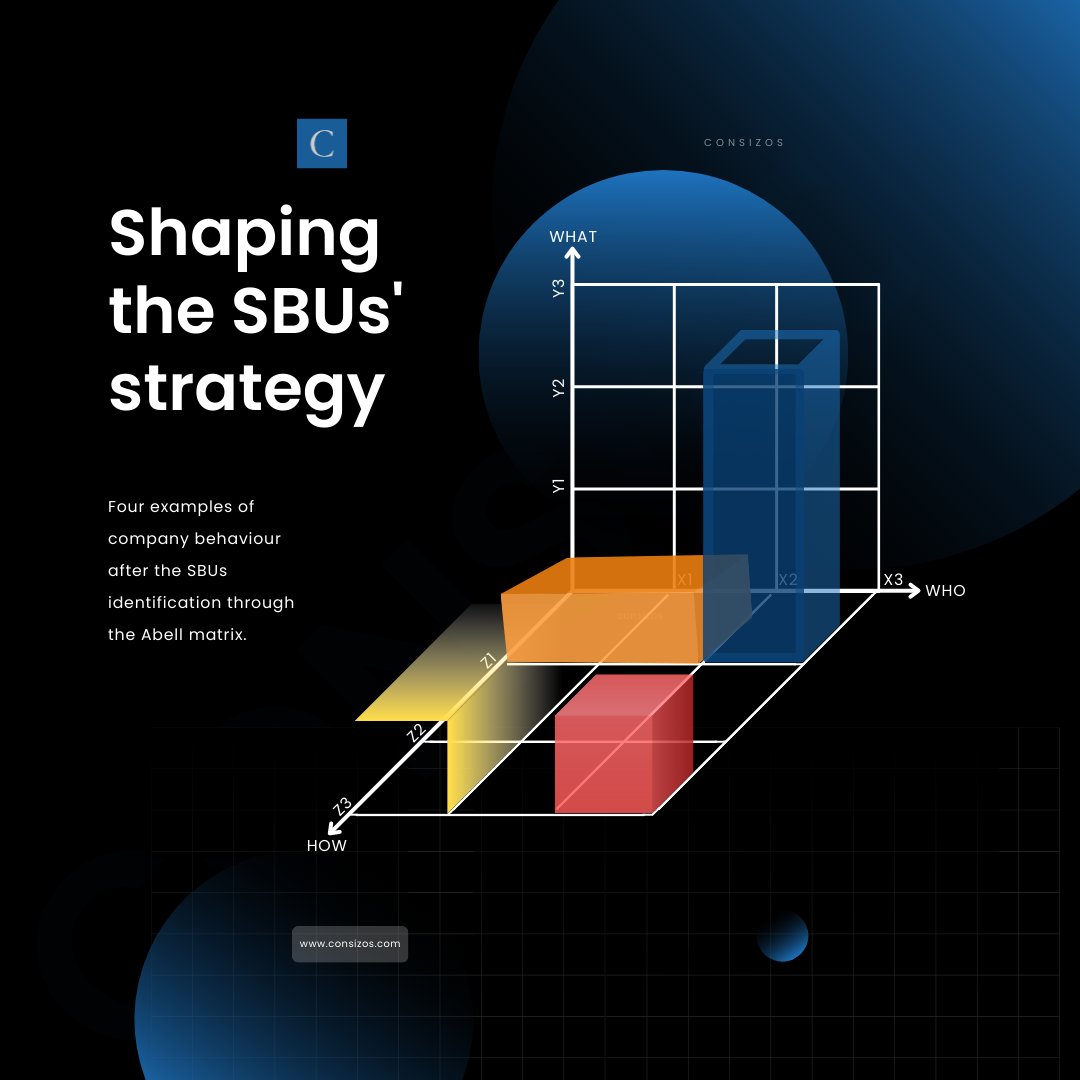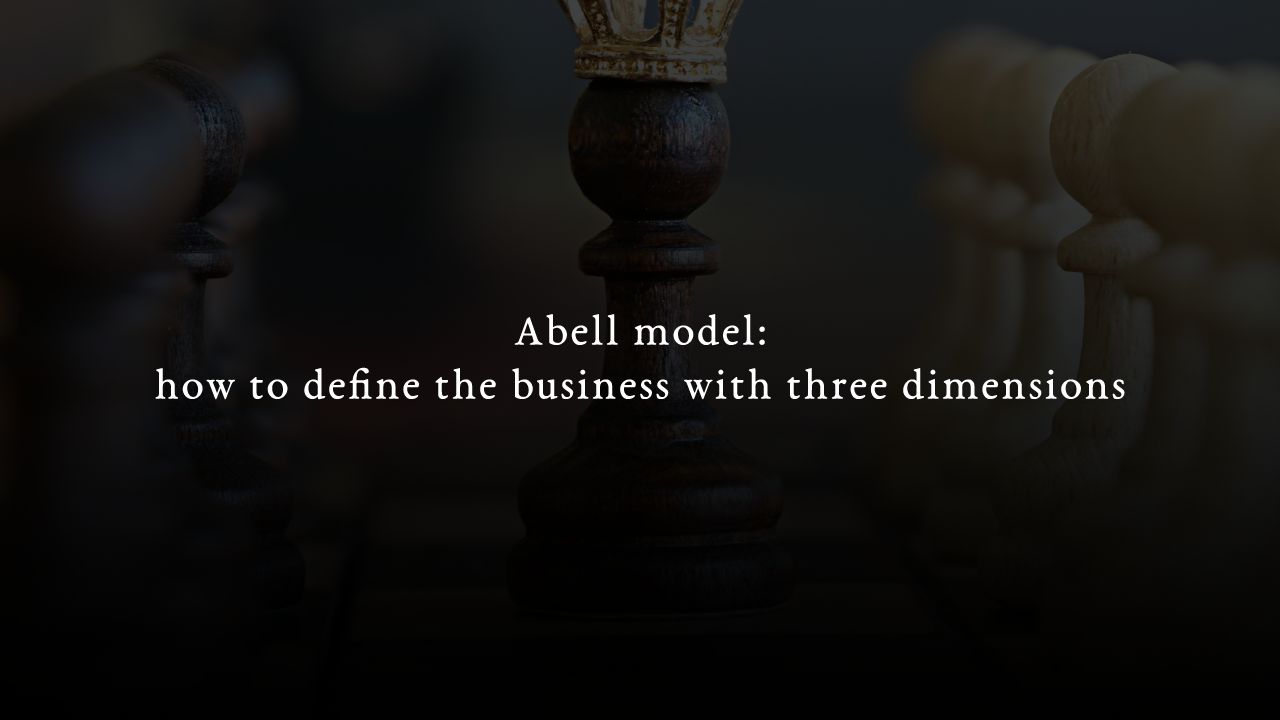Introduction
You know how big your competitive arena is? Are you struggling with market segmentation? Did you define the scope of your strategic business unit(s)? If you can’t answer any of these questions and you’re running your business with headlights off, you should probably make use of the Abell model: a simple framework for defining any business with three dimensions, it can be used to assess the current and the future scope of SBUs.
Table of Contents
- Introduction
- Why defining company’s business is crucial
- What does Strategic Business Unit (SBU) stand for?
- Abell model explained
- Look into the future
- The scope: understanding Abell’s model dimensions
- Abell Model Example
- Conclusions
- Bibliography
Why defining company’s business is crucial
Since strategy is not simply a plan or worse, a to-do-list, when the decision maker, whether he’s an entrepreneur or a manager, is involved in strategic planning the first concern is about defining the business of the company. Actually, this should be the first concern, because this point is often underestimated: some entrepreneurs consider their business boundaries as the industry where they are involved or as the market where they compete.
Technically, this is inaccurate due to three main reasons (Saloner, Shepard, Podolny, 2002, p. 176):
- The product/service could belong to a number of industries;
- The industry could include products/services that aren’t offered by the company we’re going to define;
- Substitutes and complementary goods create their own markets even though they are completely involved in the competitive arena.
If the starting point of strategic planning is wrongly formulated (think even about the case of a start up’s business plan), the concretization of the long-term plan could carry around several evaluation issues for the rest of the company’s lifecycle.
From a managerial point of view, if the manager knows the perimeter of the Strategic Business Unit he’s responsible for, he’ll know where to fight and where to go to grow.
Moreover, a proper definition of the business allows us to find hidden pockets of value, market gaps and internal areas to be improved. And that is where the Abell’s model proves its usefulness.
What does Strategic Business Unit (SBU) stand for?
The Abell Matrix is a three dimensional business definition framework developed by Harvard Professor Derek F. Abell. It is a model that has to be designed bearing in mind the business definition’s concern and the role of the Strategic Business Unit (SBU)’s competitive arena as a product/market combination. Obviously there always is a certain subjectivity degree but this is basically inevitable, even when antitrust authorities determine the company’s market their decision is subjective.
There can be multiple SBUs in the case of a larger corporation (especially in case of geographic expansion) or it may be a business into itself in the case of a small company. Indeed, The Strategic Business Unit is an autonomous entity from operations and strategy point of views. SBU’s performance is often measured in terms of Operating Income and Operating Cash Flow (OCF).
Abell model explained
Knowing the business definition concern and what a Strategic Business Unit is, we can outline the Abell model with just three lines or axes: abscissa, ordinate and applicate (customers, functions and technologies respectively). In fact, the Abell model is graphically plotted with the following three variables (Abell, 1980):
- Customer groups: the x-axis replies to the question “WHO are the customers of the organization?”. The main goal here is the customer segmentation and clustering;
- Customer functions: the y-axis replies to the question “WHAT are the customers’ needs?”. The main goal here is to deeply know the customer base until the organization get the buyer persona’s profile completed;
- (Alternative) technologies: the z-axis replies to the question “HOW can the organization meet these needs?”. Here, the goal is to find the right technique(s) to satisfy customers establishing a valuable long-lasting relationship.
In this way, it’s possible to systematically establish the starting conditions useful to investigate which internal and external factors have to be optimized in order to establish a long-term competitive advantage (Silvestrelli, Bellagamba, 2017). This is how a proper strategic planning is done: it’s fundamental to start with the x-axis and then investigate needs, only at the end of the modeling process we’ll think about tools and instruments (Abell, 1994). This axis was added by Abell around ten years after, Ed.). Nowadays, a customer-centric approach is the cornerstone of almost every market strategy in standard competition conditions, as a consequence we have to start the process from our customers, visualizing it in the center of the strategy.
Look into the future
The Abell model is often treated as a photograph of the company according to its lifecycle stage: if it’s part of a business plan we’re most likely in the seed/startup phase while if there is a structural change in a strategic perspective we’re likely in the maturity phase.
Actually, this model can generate more value if we move from a static approach to a dynamic one.
Do You drive looking in the rearview mirror? Moreover, it’s definitely better to drive looking down the street (mid-term), avoiding to look immediately near the tires (short term). For particular trips, some use a GPS (long-term)
Reconciling these two strategy aspects (static and dynamic) —what Derek Abell calls “competing with dual strategies” and Tushman and O’Reilly refer to as “the challenge of ambidexterity”—is one of the central dilemmas of strategic management. For example, the Abell Framework can help identify key customer groups and their needs, which can then be used to inform SWOT analysis by identifying potential opportunities for the company to meet those needs.
In light of this, the decision maker will develop the Abell model according to the latest innovations in strategy and economics. In particular, it’s fundamental to include prospects and non-customers in the x-axis, performing a clear but precise segmentation (now there are a number of AI applications about this). Furthermore, adding current KPIs and targets to the business mapping can provide a massive value to the management or to the entrepreneur. And eventually, the Abell model has to be revised periodically, since it’s based on customers, technologies and competitors, but most of all the Abell framework is inherently tied to a number of strategic management tools such as Porter’s 5 Forces, BCG matrix, Balanced Score Card, Canvas business model, Ansoff matrix and so on.
The scope: understanding Abell’s model dimensions
Mapping out a business, describing activities and setting boundaries often result in a cube, as we can see in the majority of books and papers. It’s a simplification, like any other model: actually, if we apply the Abell model to our business or if we use it for a theoretical example, we’ll notice that we can shape an irregular box or even an abstract shape.
The Strategic Business Unit (SBU) scope is represented by the volume of the solid.
If the groups-functions-technologies combination generates autonomous and differentiated entities there will be multiple solids or simply multiple SBUs.
Abell Model Example
Thanks to the Abell modelling, a company can align its Strategic Business Unit(s) to the overall strategy and tactics. Below, an Abell model template with four examples:
- Yellow SBU specializes in satisfying a user function and leverages existing technologies to serve their customers (e.g. Toyota);
- Red SBU focuses on a specific customer, function of use, and technology combination (e.g. Freelancer);
- Orange SBU concentrates its skills and specializes in using a particular technology to satisfy the functions of one or more groups of customers (e.g. Boeing);
- Blue SBU targets a specific buyer persona and covers several user functions with existing technology (e.g. Apple).


Conclusions
The Abell matrix shows a number of limitations, especially if the decision maker adopts it as formulated (in 1984). However, it’s still a powerful management tool because of its simplicity and the openness, primarily towards the customer driven strategy. It’s quite easy to know what the company does, but it can be tricky to accurately define the business boundaries in terms of product-market combination(s).
Bibliography
ABELL DEREK F. (1980). Defining the Business: The Starting Point of Strategic Planning. Prentice Hall: Hoboken, New Jersey.
ABELL DEREK F. (1993). Managing with Dual Strategies. Free Press: New York.
SALONER G., SHEPARD A., PODOLNY J. M. (2001). Strategic Management. John Wiley & Sons Inc.: New York.
SILVESTRELLI S., BELLAGAMBA A. (2017). Fattori di competitività dell’impresa industriale. Giappichelli: Torino.
TUSHMAN M. L., O’REILLY C. A. (2004). The Ambidextrous Organization. Harvard Business Review (pp. 74-75).

